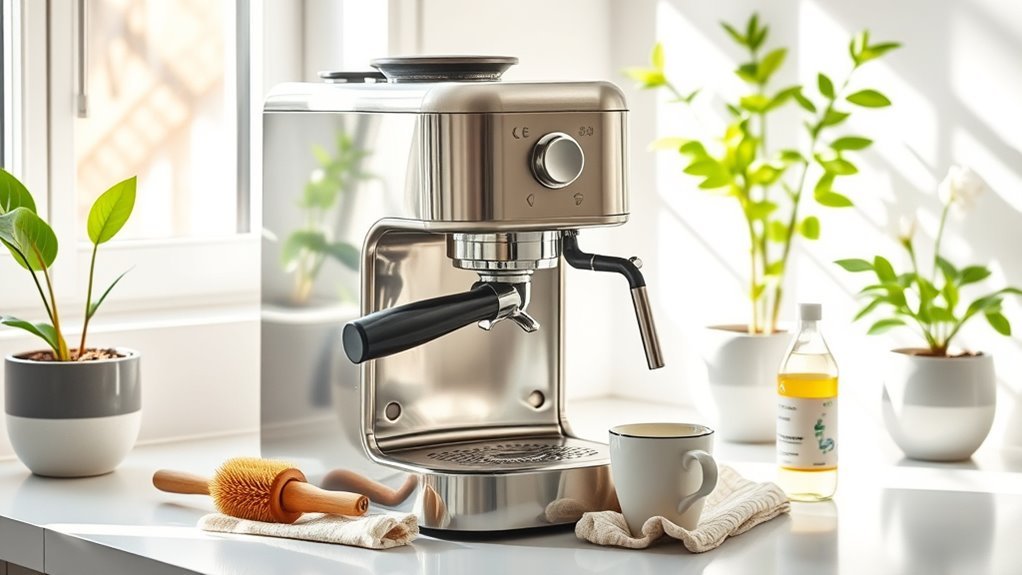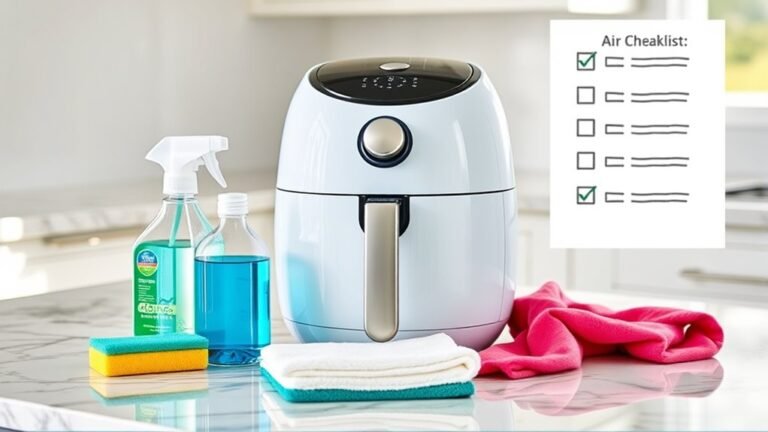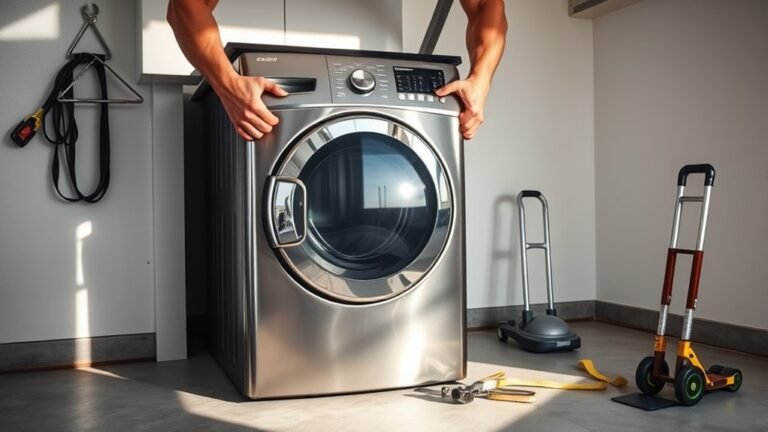Spring Cleaning Guide for Coffee Machine
To give your coffee machine a thorough spring cleaning, start by evaluating how often you use it and gather supplies like mild soap, descaling solution, a soft brush, and microfiber cloths. Unplug and disassemble parts, soak removable pieces, wipe down the exterior, and run a vinegar-water cycle to clear mineral buildup. Maintain daily by rinsing components and using filtered water. Address common issues like clogged filters or weak brews for the best taste. Keep going to uncover more handy tips for upkeep.
Assessing Your Coffee Machine’s Cleaning Needs
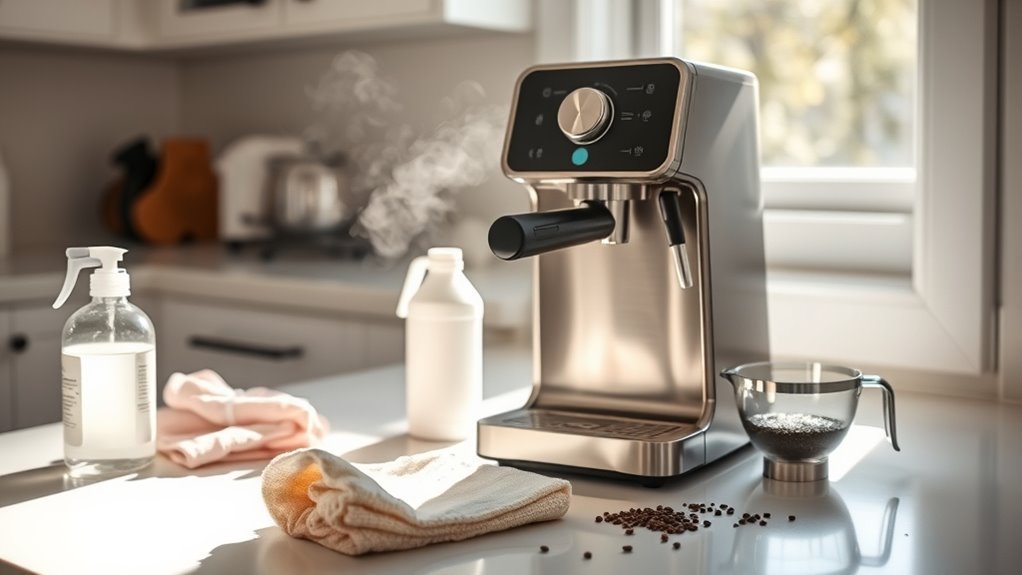
How often you should clean your coffee machine depends on how frequently you use it and the type of coffee you make. If you brew daily, sticking to a weekly cleaning frequency helps keep your machine running smoothly and guarantees every cup tastes fresh. For espresso lovers or those using milk frothers, more frequent cleanings are essential to prevent buildup. On the other hand, occasional users might get away with cleaning every few weeks. Evaluating your machine’s cleaning needs isn’t just about taste—it’s about machine longevity. Regular maintenance prevents clogs and wear, freeing you from costly repairs or replacements. By tuning into your usage patterns and adjusting your cleaning schedule, you take control, extending your coffee machine’s life while savoring every brew without interruption.
Tools and Supplies Required for Cleaning
Cleaning your coffee machine effectively requires a few essential tools and supplies that you might already have around the house. Using the right cleaning solutions and maintenance tools guarantees your machine stays in top shape, freeing you from frequent breakdowns. Here’s a quick list to get you started:
| Item | Purpose | Tips |
|---|---|---|
| Descaling solution | Removes mineral buildup | Use monthly |
| Mild dish soap | Cleans removable parts | Avoid harsh chemicals |
| Soft brush | Scrubs hard-to-reach spots | Gentle on surfaces |
| Microfiber cloth | Wipes and polishes | Lint-free |
| Maintenance tools | Tighten & adjust parts | Check manual for specs |
With these, you’re all set to maintain your coffee maker’s freedom to brew fresh, satisfying coffee anytime.
Step-by-Step Cleaning Process
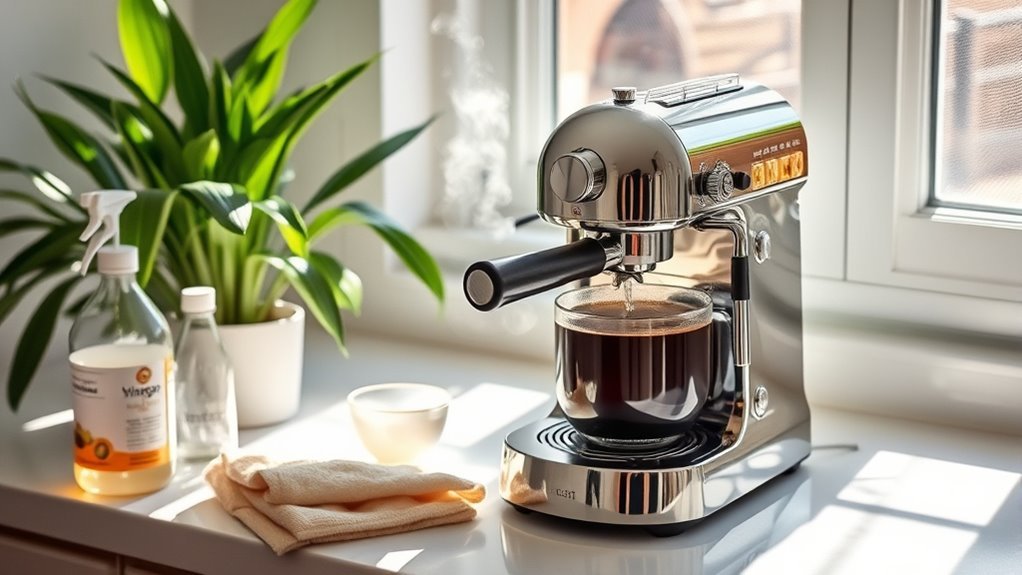
To get your coffee machine sparkling clean, follow these simple steps in order. First, unplug the machine and disassemble removable parts like the carafe and filter basket. Soak these in warm, soapy water. Next, wipe down the machine’s exterior with a damp cloth. Use a soft brush or cloth to clean any coffee grounds or residue inside. For a deep clean, run a mixture of equal parts water and white vinegar through a brewing cycle, then run two cycles of plain water to rinse. Pay attention to your cleaning frequency—aim for a deep clean every month to enjoy fresh coffee and prevent buildup. These maintenance tips will keep your machine running smoothly and guarantee your coffee tastes great, giving you the freedom to savor every cup.
Maintaining Your Coffee Maker Between Deep Cleans
Keeping your coffee maker in good shape between deep cleans is just as important as the thorough monthly routine. Daily maintenance helps you enjoy consistently fresh coffee without hassle. After each use, rinse the carafe and brew basket to prevent stale residue buildup that can affect coffee freshness. Wipe down the exterior and the warming plate to avoid sticky spots. Empty used grounds promptly to keep your machine running smoothly. Using filtered water can reduce mineral deposits, extending the time between deep cleans. Taking these small steps gives you freedom from frequent, intensive scrubbing and keeps your coffee tasting vibrant. By committing to simple daily maintenance, you guarantee your coffee maker stays reliable, letting you savor every cup without interruptions or compromises.
Troubleshooting Common Coffee Maker Issues
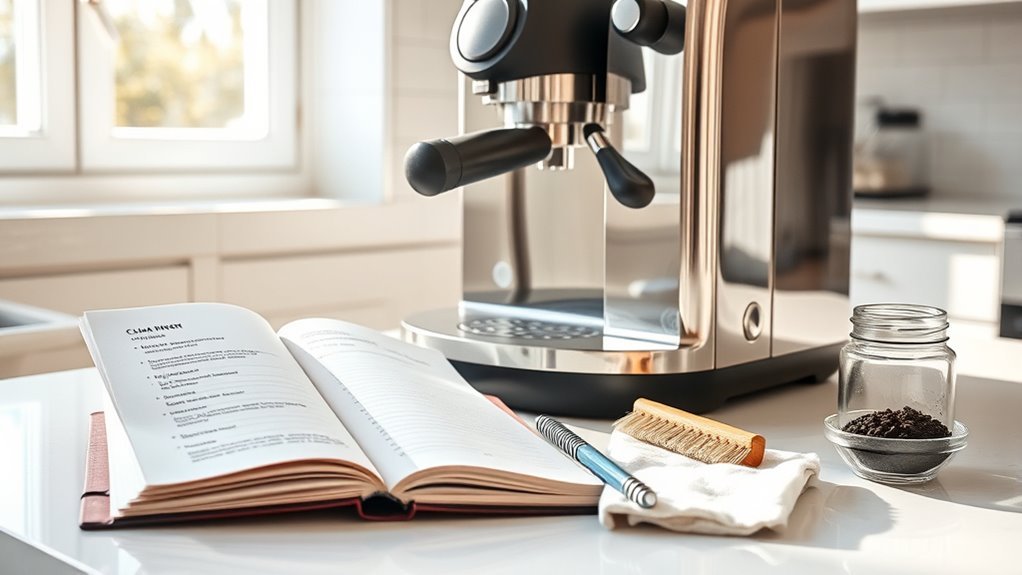
Although coffee makers are designed for convenience, you might still encounter issues like weak brews, slow dripping, or unusual noises. These brewing problems often stem from clogged filters or mineral buildup inside your machine. Start by descaling your coffee maker regularly to prevent machine malfunctions. If your coffee tastes off, check the grind size and water temperature. Slow dripping could mean the water reservoir isn’t seated correctly or there’s a blockage in the tubing. Unusual noises might indicate a worn-out pump or loose parts. Don’t let these hiccups restrict your freedom to enjoy great coffee. By knowing how to troubleshoot common coffee maker issues, you’ll keep your machine running smoothly and your coffee tasting fresh without relying on costly repairs or replacements.
Frequently Asked Questions
Can I Use Vinegar Instead of Commercial Descaling Solutions?
You might wonder if vinegar benefits your coffee machine as a descaling alternative. While vinegar is a popular, natural choice and can be effective at breaking down mineral buildup, it’s acidic and might leave a lingering smell or taste. If you want freedom from harsh chemicals, vinegar’s a budget-friendly option, but make sure to rinse thoroughly. Commercial solutions are designed specifically for machines, so weigh convenience against your preference for natural methods.
How Often Should I Replace My Coffee Machine’S Water Filter?
You should replace your coffee machine’s water filter every two to three months, depending on the filter lifespan specified by the manufacturer. If your water quality is poor or has a lot of minerals, you might need to swap it out more often. Keeping a fresh filter not only extends your machine’s life but also frees you from unpleasant tastes, letting you enjoy your coffee without restrictions or worries about buildup.
Is It Safe to Clean My Coffee Maker in a Dishwasher?
Throwing your coffee maker parts into the dishwasher might feel like setting them free on a wild water ride, but you’ve got to check dishwasher safety first. Not all components are dishwasher-friendly—some plastics can warp or lose flavor. Instead, embrace gentle cleaning methods like hand washing with warm soapy water for a longer-lasting brew. This way, you stay in control, keeping your coffee maker happy without risking damage.
What’S the Best Way to Clean Reusable Coffee Pods?
To keep your reusable coffee pods in top shape, you’ll want to clean them regularly—ideally after every use. Different reusable pod materials, like stainless steel or plastic, need slightly different care. Stainless steel pods can usually be rinsed or washed with mild soap, while plastic ones might require gentler handling to avoid damage. Staying consistent with cleaning frequency guarantees you enjoy fresh, flavorful coffee without any leftover residue holding you back.
Can Mold Grow Inside My Coffee Machine if Not Cleaned Regularly?
Yes, mold can definitely grow inside your coffee machine if you don’t clean it regularly. To keep mold prevention on point and maintain good coffee hygiene, you’ve got to clean all parts that hold water or coffee oils. Doing this not only guarantees your coffee tastes great but also keeps your machine safe to use. Regular cleaning gives you the freedom to enjoy every cup without worrying about unwanted guests like mold.
